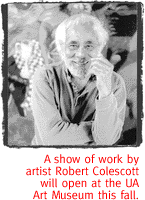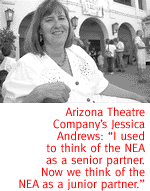

|

As Washington's Funding For The Arts Dries Up, Corporations Become More Generous -- But At What Cost?
By Margaret Regan
JIM KOLBE, THE moderate Republican congressman from Southern
Arizona's District 5, likes the arts.
For years, he's been a season subscriber to the Arizona Theatre
Company and Tucson Symphony Orchestra, and he goes to Arizona
Opera when he can. Just recently, in Washington, D.C., between
Congressional sessions, he took in an Ansel Adams photography
show and the theatrical hit Ragtime. And, he says, he's
a believer in the National Endowment for the Arts.
"It does good things, far beyond the amount of dollars spent,"
he said earlier this week at a reception held in Tucson to honor
local recipients of the 1998 NEA grants.
So why has he voted for drastic reductions in NEA funding?
"I did support the cutback. We were at an impasse,"
said Kolbe. "Some believe strongly that funding of the arts
is not something the government should do."
 The way Kolbe sees it, he helped save the NEA by cutting it down
to size. A federal agency created in 1966 and charged with bringing
the arts to the American people, the NEA by the early '90s had
become a hotly contested symbol in the culture wars. As a member
of the appropriations subcommittee, Kolbe helped hammer out a
compromise between furious conservatives who wanted to abolish
the NEA altogether and liberals who favored keeping it up to strength.
NEA saw its budget plummet from $162 million in fiscal 1995 to
$99 million in fiscal 1996. It slid further to $98 million in
the last year.
The way Kolbe sees it, he helped save the NEA by cutting it down
to size. A federal agency created in 1966 and charged with bringing
the arts to the American people, the NEA by the early '90s had
become a hotly contested symbol in the culture wars. As a member
of the appropriations subcommittee, Kolbe helped hammer out a
compromise between furious conservatives who wanted to abolish
the NEA altogether and liberals who favored keeping it up to strength.
NEA saw its budget plummet from $162 million in fiscal 1995 to
$99 million in fiscal 1996. It slid further to $98 million in
the last year.
Just last Friday, Republicans allied with the Christian Right,
leading a clamorous new charge on social issues, vowed anew to
demolish the NEA. President Clinton meanwhile has proposed pushing
its budget back up to $136 million.
Kolbe believes, "there's a fair degree of assurance funding
will be continued," probably at this year's level of $98
million.
The compromise in the meantime has put a host of new restrictions
on the NEA. Grants to individual artists, the big political hot
potato, were banned, with a few exceptions. Six politicians, members
of Congress, were put on the NEA board as watchdogs. Kolbe finds
the reforms "good and reasonable"; he's pleased that
the new NEA must give a bigger percentage of its money directly
back to the states.
"That's good," he said. "We know locally what's
good."
Indeed, the Arizona Commission on the Arts this year got almost
$600,000, the bulk of that designated for its successful arts-in-education
program, and Arizona as a whole got $1.25 million. The trouble
is, the percentage may be larger, as Kolbe said, but the actual
dollars are down, acknowledged Shelley Cohn, director of the state
commission.
 And in the three years under the meaner, leaner NEA, arts institutions
have struggled, in Tucson and elsewhere. Museums now are ineligible
for basic grants to support the unsexy but vital work of conservation
and cataloging. Theatre companies and other performing arts groups
can no longer get unrestricted NEA support for a whole season.
Their requests must be targeted to specific projects; those most
likely to get funded are socially useful schemes like providing
arts for kids or trying to reach underserved audiences.
And in the three years under the meaner, leaner NEA, arts institutions
have struggled, in Tucson and elsewhere. Museums now are ineligible
for basic grants to support the unsexy but vital work of conservation
and cataloging. Theatre companies and other performing arts groups
can no longer get unrestricted NEA support for a whole season.
Their requests must be targeted to specific projects; those most
likely to get funded are socially useful schemes like providing
arts for kids or trying to reach underserved audiences.
Coming a week after a couple of Tucson arts agencies actually
got more money from the city, the NEA ceremony at the University
of Arizona Museum of Art was low-key and scrupulously polite.
The recipients all took care to pronounce themselves pleased
with their grants, even though the money pales by comparison to
what it was when the NEA was flush.
Terence Pitts, director of the center for the Center for Creative
Photography, which got $50,000, made the boldest declaration.
"I can't imagine $50,000 of federal funds better spent,"
he said. "It will be in our endowment forever."
But the Center once got $60,000 to $75,000 regularly, every year,
to help preserve the priceless photographs in its collections,
including Ansel Adams works like those Kolbe enjoyed in Washington.
No more. The new $50,000 stabilization grant, stashed in an interest-earning
endowment, will generate about $2,500 in usable money every year,
said assistant director Nancy Lutz. Like most arts groups, the
Center will use the NEA grant "as a tool to get more money."
In fact, the NEA requires the Center to double the grant with
$100,000 in privately raised money, and Lutz said staff hopes
to keep going up to $1 million.
The Arizona Theatre Company will use its $16,500 from the NEA
to make its productions more accessible, said executive director
Jessica Andrews. Plans call for audio descriptions of plays for
the blind and sign language interpretations, and a scheme to draw
in a more diverse audience. In the old days, Andrews said after
the reception, ATC got about $60,000 to $65,000 every year.
"We used to think of the NEA as a senior partner,"
she said, "now we think of the NEA as a junior partner."
 The UAMA got a pitiful $8,000 to help pay some travel expenses
for the big Robert Colescott show that will open this fall. The
exhibition will allow Tucsonans to see the same paintings that
their hometown artist displayed in Venice last fall at the prestigious
Venice Biennale. The stipend fell fall short of the museum's request
of $21,000, assistant director Lee Karpicsak said afterward; it
doesn't begin to approach the old days, when the museum got about
$155,000 over seven years. Even Kolbe had to admit that the UAMA
"got a small amount," but he declared that it will nonetheless
"enhance the exhibit."
The UAMA got a pitiful $8,000 to help pay some travel expenses
for the big Robert Colescott show that will open this fall. The
exhibition will allow Tucsonans to see the same paintings that
their hometown artist displayed in Venice last fall at the prestigious
Venice Biennale. The stipend fell fall short of the museum's request
of $21,000, assistant director Lee Karpicsak said afterward; it
doesn't begin to approach the old days, when the museum got about
$155,000 over seven years. Even Kolbe had to admit that the UAMA
"got a small amount," but he declared that it will nonetheless
"enhance the exhibit."
Elizabeth Evans, a novelist and an English prof at the UA, was
a big winner with a $20,000 grant, which will support her as she
writes her third novel, Little Sister. The Congressional
reformers ruled that writers, like Evans, can still get individual
artist grants. Books apparently have a lower shock quotient than
paintings or photographs. In the wake of controversies over Robert
Mapplethorpe and Andres Serrano, visual artists are out of luck.
WHILE THE MOOD was decidedly subdued among the NEA recipients--the
joyous Evans excepted--Dian Magie of Tucson Pima Arts Council
was downright jubilant. The city council voted unanimously last
week to jump TPAC's city funding by $200,000, going from last
year's $612,500 up to $812,500.
"All of the $200,000 will go directly into re-granting,"
Magie said earlier this week. "We already have the administration
in place."
TPAC hands out much of its money as direct "re-grants"
to a host of arts organizations big and small, from Arizona Theatre
Company to a neighborhood arts project in Barrio Anita. The hike
was the first in the re-granting category in 10 years, Magie
said. TPAC gets some of its budget of $1.6 million from other
sources, including NEA money that trickles down through the Arizona
Commission, but the city pays the lion's share out of its dollar-a-night
hotel tax, which also helps fund the Tucson Arts District Partnership.
The Partnership had reason to be gleeful too. Sarah Clements
said her group ultimately got the same amount it did last year--$320,000--but
only after she went a-begging for the $90,000 of it that's designated
for the warehouse loan program. Right now the loan money for arts
spaces in the old warehouse district at the north edge of downtown
is considered an extra. Clements said she's trying to persuade
that city "that this is our basic need." By the end
of this year, she pointed out, the loans will have spurred the
development of some 75,000 square feet of arts space in formerly
dilapidated buildings. Both Clements and Magie believe city leaders
have come around to the idea that the arts are an engine for economic
development.
"They're looking at it as an investment," Clements
said.
 The only loser in the city arts sweepstakes was the Tucson Museum
of Art. The city council was in no mood to give TMA the raise
it asked for, $32,000 above last-year's subsidy of $86,000. City
leaders are smarting from the impending loss of Janos Restaurant,
which the expanding TMA is forcing out of one of the historic
houses it holds in trust for the city. Janos, acclaimed in restaurant
circles nationwide, contributed some $29,000 in tax dollars annually
to the city. In September it will decamp to the foothills aerie
of La Paloma, beyond the reach of the city tax collector.
The only loser in the city arts sweepstakes was the Tucson Museum
of Art. The city council was in no mood to give TMA the raise
it asked for, $32,000 above last-year's subsidy of $86,000. City
leaders are smarting from the impending loss of Janos Restaurant,
which the expanding TMA is forcing out of one of the historic
houses it holds in trust for the city. Janos, acclaimed in restaurant
circles nationwide, contributed some $29,000 in tax dollars annually
to the city. In September it will decamp to the foothills aerie
of La Paloma, beyond the reach of the city tax collector.
ANYWAY, RIGHT NOW, the TMA is enjoying the kind of corporate
support that Kolbe said he favors as a replacement for government
largesse. The Ford Motor Company gave the museum $81,000 to help
pay for the big El Alma del Pueblo Spanish folk arts show.
But the Ford example is instructive.
Even the most casual visitor to TMA can hardly miss the fact
that Ford is the big sponsor. Advertising logos are ubiquitous,
on catalogs, on signs, on the free tickets that were to be distributed
to every schoolchild in Tucson. Ford reps called local arts reporters,
including this one, to ask them to mention the company in reviews
of the show. A luncheon for reporters, purportedly about the exhibition,
turned into a long advertisement for the company and all its good
works. And the Ford reps strong-armed museum staff too: throwing
a fit when some corporate drones were left off a guest list, micromanaging
publicity materials, menus and so on.
"Mostly companies want something that has a lot of publicity
attached," said Lutz, of the Center for Creative Photography.
"They want to sell a product. Otherwise they're not interested."
They're not interested, just for example, in the behind-the-scenes
work necessary to keep the Center's archives of Ansel Adams and
other photographers in tip-top shape. Corporations like splashy,
uncontroversial, high-attendance shows that allow them maximum
advertising. Kolbe said he dislikes the government giving an "imprimatur"
to certain art through NEA funding. As that money disappears,
though, it's the profit-making corporations who get to give the
stamp of approval. Art can become just one more tax-deductible
way to sell a widget, or a car.
"We have not had the experience of a corporation being (as)
demanding (as Ford)," Lutz said. "But big corporations
do want something in return."

|
 |





